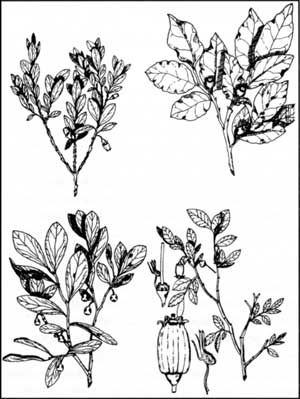Huckleberries
Delicious wild fruit has never been cited as the primary, or even a secondary, reason for why people come to Crater Lake. Few of them know that the park contains four species of huckleberries, and are aware of the lone exception to rules prohibiting collection of plant material in Crater Lake National Park. Each person is allowed one quart of huckleberries per day for personal use, largely because picking does not appear to interfere with perpetuating the host shrub. Bears will forage for ripe huckleberries (as I found out one afternoon in the Sky Lakes Wilderness south of Crater Lake), but this inclination has yet to bring them into conflict with human visitors to the park.
All four huckleberry species are in the genus Vaccinium, which belongs to the Ericaceae(heath) family. This group of plants is distributed worldwide and contains roughly 3,300 species in 103 genera. Most thrive, as the family name suggests, on uncultivated land with inferior drainage. This is usually where the soil is poor, often coarse, and sometimes acidic.
The swamp huckleberry, V. occidentale, likes the western border of the park where it forms dense thickets along streams. It is also known as the westernbog blueberry, since western North American “huckleberries” are really blueberries. (True huckleberries are classed in the genus Gaylussachia, a group much more prevalent in Europe than in the United States). In any event, this plant yields tasty bluish-black berries which usually ripen by early August. They can be had in easily accessible areas such as Boundary Spring, Sphagnum Bog, and Red Blanket Creek.
Bluish-black berries can also be seen on the dwarf or mat huckleberry, V. caespitosum.These shrubs are less than a foot high, with most only a few inches off the ground. They are found in many places around the park, but are probably most evident in the Castle Crest Wildflower Garden, Vidae Falls, Annie Spring, and Wheeler Creek.
The broom huckleberry, V. scoparium, is also known as grouseberry. Some North American Indian groups call it fireberry due to the color of the fruits. This plant possesses bright red berries which are edible and sweet, though usually too small for picking in any quantity. Being the most drought-tolerant species in the genus, it is abundant in lodgepole (Pinus contorta) and mountain hemlock (Tsuga mertensiana)forests throughout the park.
What is certain to be the most sought-after member of the genus, V. membranaceum,goes by several common names. It is variously known as the big, thinleaf, or mountain huckleberry, as well as Ewam to speakers of the Klamath language. This shrub, which is between two and five feet in height, appears as widely branched bushes containing thin leaves that usually measure over an inch long. Its berries are reddish- to purplish-black when they ripen during the first half of August. There are patches southwest of Park Headquarters, but most pickers go to an old burn area on Huckleberry Mountain(Ewamcan in Klamath) in the Rogue River National Forest where more sunlight has enhanced flowering and fruiting.
A visit to Huckleberry Mountain can be combined with a trip to see Crater Lake because it is located less than three miles west of the park boundary. Follow posted signs from the snowpark located on Highway 62 to a primitive campground situated within the huckleberry patches. The bushes cover a relatively broad area, so you will have plenty of options for where to spend a couple of hours picking berries. After a couple of afternoons there last August, I remembered that Henry David Thoreau once quoted Pliny in describing huckleberries, In minimis Natura praestat, Nature excels in the least things. Anyone who has tasted the fruit from Huckleberry Mountain will agree, especially if they are fortunate enough to savor it in pie, jam, or pancakes!
The author would like to thank Joy Mastrogiuseppe for reviewing this article and her suggestions.
Steve Mark has worked as park historian at Crater Lake and Oregon Caves since 1988.
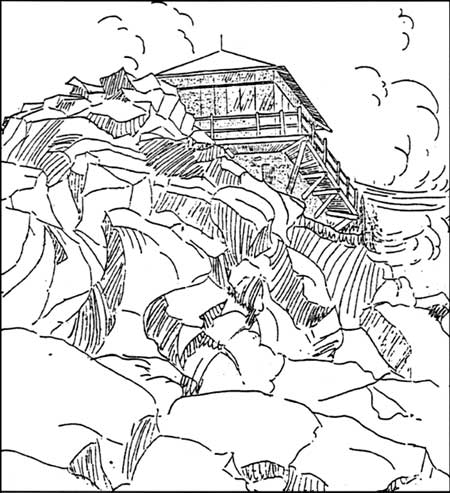
The Watchman Lookout as depicted in the July 1933 Nature Notes from Crater Lake.
A Natural History of My Refugium: Seven Summers in Crater Lake National Park (1)
It was 6 a.m. and cloudy on the gray spring morning when we flew from Ashland’s airport in a small four-passenger plane. We rose above the clouds at 5,000 feet and in short order headed east into the breaking dawn. The sky grew lighter and ever so colorful as the sun began to rise. Within a half hour I could see the gray stillness of Crater Lake as the dawn’s light bounced down the caldera walls. I always knew Wizard Island was supposed to be a nearly perfect cinder cone, but as we circled high above the lake, we were able to see just how perfectly it was shaped because the snow traces radiated down along its slopes, just like the spokes of a wheel. By 7:00 we landed back in Ashland, where the town was just awakening to another gray, dreary morning. But we were not drowsy and feeling under a burden of dark clouds, having just experienced a sunrise flight over Crater Lake!
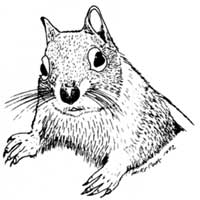 Golden mantled ground squirrel. Drawing by Mike Cook, 1992. |
I enjoyed many days hiking and camping during my employment at the park. We discovered many differing habitats, and even climbed Mount Thielson, the peak that towers over Diamond Lake. Though we came to expect golden mantled ground squirrels (Citellus lateralis) along the rim of Crater Lake,2 we were surprised to see one at the very top of Thielson, begging for a handout!
Anywhere I went within the park, I would be greeted by some form of wildlife. Once, while walking along the base of a talus slope near Park Headquarters, I came across a doe and her fawn. In their attempt to avoid me, they could not run away because of the big, blocky boulders they had to cross. So they just walked away. One animal often heard, but rarely seen, is the pika(Ochotona princeps). I often heard them along the caldera walls as I hiked down the Cleetwood trail to the lake’s edge. The first one I ever saw was also the only one that I was able to photograph! It is these little lagamorphs that I miss on my treks in Olympic National Park since they never populated the isolated Olympic Peninsula.
I have had the unique opportunity to “talk” with some of the spotted owls (Strix occidentalis caurina) living within the boundaries of Crater Lake National Park. During my first year as a ranger, I read through the preliminary reports of spotted owl surveys conducted in the park in 1976. Since I had been involved with a spotted owl survey for the Forest Service prior to working at Crater Lake, I was eager to help with work in the park. Even though it was late in the summer of 1977, we were able to locate the owls seen the year before and find a couple of new locations. More surveys followed the next year, along with some predictions for where these birds might be found in the future. Not until 1992 were more in depth surveys conducted, but they found owls in the predicted locations!3
One of my favorite places to visit is Anderson Falls. Not many visitors know about it, or how to get there, because there are no formal trails leading to this spectacular feature.4 One can almost melt into the scenery there, where wildflowers wave at your knees. Upon the cliff above these falls are onions (Allium validum) that grow nearly up to your waist! And are they ever tasty…and strong! I admit that I ate a couple, and then progressed to taste those powerful bulbs the rest of that day and even through breakfast the next day!
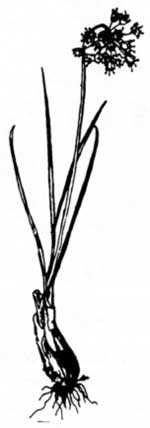 Wild onion. |
A fellow employee and I once got trapped in a hail storm near Anderson Falls. We found refuge in a small cave along the cliff, but knew that we had to get back to Rim Village. After running back to Rim Drive, a visitor picked us up and took us to the lodge. There were quite a line of cars headed down the mountain, since those visitors did not want to stay around to weather the storm. Very shortly after we reached the lodge, however, the rain stopped. We were the only ones left on the rim, it seemed, and then the clouds began to lift. As if we were the only ones who were meant to see, a rainbow formed and arched low over the lake. It moved across the water to the other side as the storm clouds headed eastward, and washed the rim wall with its colors.
Crater Lake itself seems to have many colors, textures, and moods that change frequently. Though the lake seems to be ever constant, staying the same year after year, one has only to spend a day along its edge to know differently. Some visitors stay for only an hour or two, and of course fail to appreciate the subtle and dramatic changes that take place.
The water is not blue, nor gray, but is crystal clear. Sunlight penetrates the water, some of which is reflected, but most is refracted or bent by the water molecules in the lake. White light from the sun is a blend of all visible wavelengths and penetrates Crater Lake’s surface. Most of the reds and yellows are absorbed in the first few feet of water. The greens that are often seen along the lake’s edge and around Wizard Island reach down further, but become absorbed at relatively shallow depth. Blues reach the deepest, with these wavelengths being scattered and bent. Much of that blue light is reflected toward us. This provides that deep blue as we gaze at the lake. The color of Crater Lake at any one time is influenced by the intensity of sunlight, cloud cover, and suspended particles in the water.
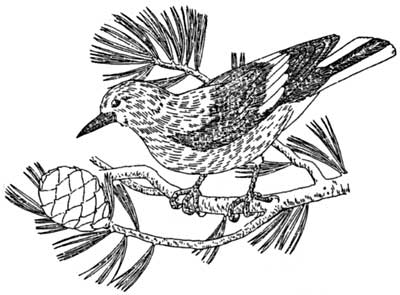
Clark’s nutcracker. Drawing by L. Howard Crawford, 1936.
Sometimes the clouds pour into the caldera, much like water from the spout of a pitcher, reminding one of the witches cauldron in Shakespeare’s Macbeth. The differences in air pressure and temperatures between the caldera and surrounding mountain slopes, often cause clouds to rise or descend. On one occasion, when the clouds poured into the caldera, they descended along the lake surface but left the rim walls and Wizard Island’s conical peak poking out of the blanket. Although park employees knew this was a rare event, some visitors were puzzled and subsequently complained because they came to see the lake, not a bunch of clouds! If only they could understand how special this event was, they might have joined in the excitement.
Along much of the rim you can observe the survival struggle of whitebark pine (Pinus albicaulis). Their growth is limited by the slope, aspect, direction and strength of winds or storms, availability of water, and the Clark’s nutcracker (Nucifraga columbiana). The resinous cones are sealed to protect the seeds from most predators, but the Clark’s nutcracker (as its name implies) can break open these cones. It is as though this bird has just the right tool to pick the lock on this safe of seeds. They cache the seeds for their winter food supply, which is usually located along a ridge top where winter winds scour the snow. The bird does not always find its caches, so this eventually results in another crop of whitebark pines! Ornithologists believe that the tree and bird co-evolved, for the tree depends upon the bird to plant its seeds.
Ernest G. Moll, in his collection of poems about Crater Lake, wrote of the whitebark pine:
On this torn ridge he rooted, proud and free,
Battling the wild earth-forces for control;
Life granted not his dream of beauty, so he,
Majestically dying, reached his goal.
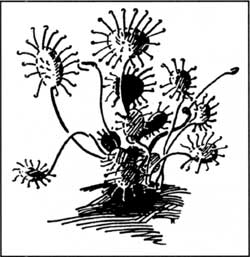 Sundew. Drawing by Walter Rivers, 1948. |
Crater Lake is also where I began to learn many of my wildflowers. The glacier lilies (Erythronium grandiflorum) that sprout along the Rim Drive are one of the first flowers to come up through the snow in early summer. Adorning the south facing and drier talus rock slopes are the pasque flowers(Anemone occidentalis). As the flowers fade, the stems grow high above the rocks, pushing the pom pom-like seedheads into the wind. This allows seeds to be dispersed more easily.
Sphagnum Bog, a marshy area along the western boundary of the park, hosts several insectivorous plants such as two species of sundew (Drosera anglica and D. rotundifolia) and the butterwort(Pinguicula vulgaris).5 Tiny insects get stuck on the Sundew surface of their leaves or showy parts and are “digested” right there. This gives the plants a source of nitrogen, a substance not found in high supply around boggy areas. I hiked out there to find the sundews and photograph them, but not until later did I realize I had butterworts among the sundews in my pictures! A somewhat similar area is Thousand Springs, an area south of Sphagnum Bog, where I found the aster fleabane (Erigeron peregrinus var. callianthemus), arrowleaf groundsel (Senecio triangularis), and two species of bog orchids (Habenaria dilatata and H. stricta).
Beargrass (Xerophyllum tenax) was not to be found in Crater Lake National Park, or so I had read in a wildflower book.6 Being rather curious about this plant, I asked Ron Mastrogiuseppe. He answered that it had recently been located, but would not say where. Over the course of that summer, though, Ron gave me two hints about its location. One was “pre- Mazama landscape” and the other was “refugium.” I had heard of a refuge, but not refugium. The latter word appeared in a geologist’s dictionary, with the definition being “a place that had been protected in some way from a climactic event.”
After some study, I approached Ron with some possibilities for where beargrass might be found. He smiled and sent me out to locate the plants in early September. In an area only 40 feet or so square, along a small rocky ridge, I found some withered stalks!7Charlie Bacon, whose work has substantially changed our understanding of the park’s geological story, told me later that there were no refugia — that is to say, protected areas within what is now the park when Mazama’s climactic eruption took place 7,700 years ago.8 He figured that birds had deposited the seeds. Even so, it is fascinating to consider the possibility of such a refugium.
Although the park may not have been a refuge for life at the time of the big eruption, it certainly is now. When things become too hectic, I return for a visit to Crater Lake and it rejuvenates me. Crater Lake seems like home after spending seven summers of my life there, a place where one can relax and feel like they belong. That feeling has persisted for two decades in Crater Lake National Park, my refugium.
Notes
1 Edited from an interpretive slide program presented at a symposium entitled Crater Lake National Park: Still Beautiful at 90, on May 16, 1992.
2 See Roger Brandt’s article on this topic in the 1993 volume of Nature Notes from Crater Lake.
3 See Lori Stonum’s article on spotted owl survey in the 1993 issue of Nature Notes.
4 It is, however, less than a half mile from the East Rim Drive.
5 More detail about Sphagnum Bog can be found in the article by Jean Danielson and Steve Mark which appeared in the 1994 volume of Nature Notes.
6 See Elizabeth L. Horn, Wildflowers 1: The Cascades. Beaverton: The Touchstone Press, 1972 (p. 58).
7 This occurred in 1978. See Mastrogiuseppe’s article on pp. 12-14 in the 1994 issue ofNature Notes.
8 New evidence refutes Bacon’s position, but more study of Sphagnum Bog is needed.
John Simmons began his career as a park naturalist at Crater Lake and is presently stationed at Canyonlands National Park.
Other pages in this section

